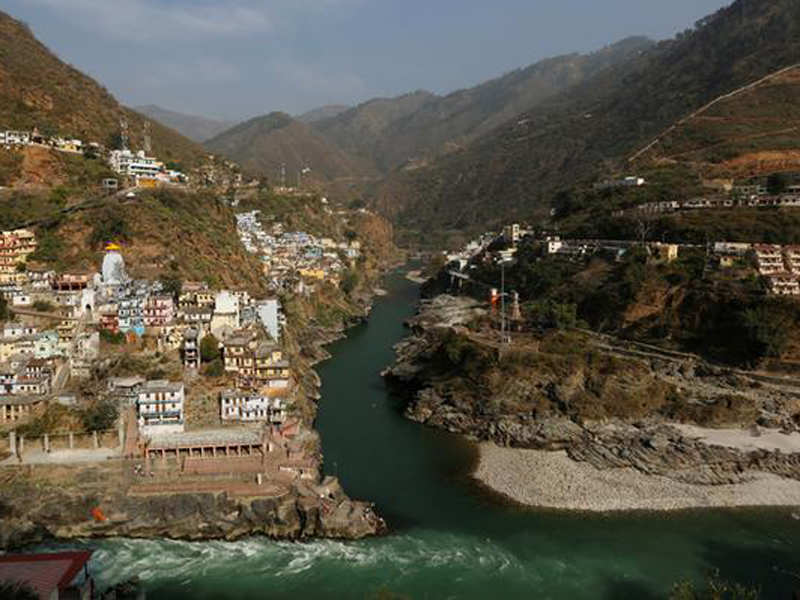 NEW DELHI: Thirteen towns across four countries, including five from India (Mussoorie, Devprayag, Singtam, Kalimpong and Darjeeling), in the Hindu Kush
NEW DELHI: Thirteen towns across four countries, including five from India (Mussoorie, Devprayag, Singtam, Kalimpong and Darjeeling), in the Hindu Kush
Himalayan (HKH) region, are facing increased water insecurity, said a study, published in the journal Water on Sunday.
The study also explained the reasons behind the phenomena where “urban Himalaya is running dry” despite being in the region of high water availability.
The remaining eight towns are in three different countries - Nepal (Kathmandu, Bharatpur, Tansen and Damauli), Pakistan (Murree and Havelian) and Bangladesh (Sylhet and Chittagong).

Case study sites in HKH region. Source: ICIMOD
Though Shimla is not part of this study as one of the 13 urban sites, reasons of increased water insecurity there during summer could well be explained by this phenomenon which is marked by poor water governance, lack of urban planning and climate-related risks.
The study, the first of its kind on the HKH region, also shows that the interlinkages of water availability, water supply systems, rapid urbanization, and consequent increase in demand (both daily and seasonal) are leading to water insecurity in these towns which has consistently been showing the increase in population and tourist flow.
“There is a high dependence on springs (ranging between 50% and 100%) for water supply in three-fourths of the urban areas. Under current trends, the demand-supply gap may double by 2050. A holistic water management approach that includes spring-shed management and planned adaptation is therefore paramount for securing safe water supply in the urban Himalaya,” said Anjal Prakash
, one of the editors of the report on this study - Mapping challenges for adaptive water management in Himalayan towns.
Prakash, research director at Bharti Institute of Public Policy
, Indian School of Business, Hyderabad and a coordinating lead author for the IPCC special report on Ocean and Cryosphere, noted the relevance of such study for other Himalayan towns, such as Shimla, as well. “Issues are very similar across all the hill towns,” he told TOI on Sunday.
The study was carried out under a programmed led by the International Centre
(ICIMOD) - an intergovernmental body in Kathmandu which works for eight regional member countries – Afghanistan, Bangladesh, Bhutan, China, India, Myanmar, Nepal, and Pakistan. It analysed demand-supply gap, projected population, available sources of water and challenges of climate risks in case of extreme weather events in the HKH region to arrive at its findings
Analyzing water management of Himalayan urban, the report noted that the encroachment and degradation of natural water bodies (springs, ponds, lakes, canals, and rivers) and the growing disappearance of traditional water systems (stone spouts, wells, and local water tanks) are evident in the entire region.
“This study is an extremely relevant and timely reminder of the need for securing the water supply to the urbanising cities in the Himalayan region. It faces the impacts of climate change on distribution and availability of water in the longer run while having to deal with the immediate stress of disappearing natural water bodies and traditional water conservation practices,” said Purnamita Dasgupta
, Professor, Institute of Economic Growth.
Underlining the need to take measures in view of future demand, the study points out that though only 3% of the total HKH population lives in larger cities and 8% in smaller towns, projections show that more than 50% of the population will be living in cities by 2050. “This will naturally place tremendous stress on water availability,” it said.
As part of its suggestions to deal with the issues concerning water insecurity in the urban Himalaya, the study emphasised on the need to protect springs, increase water harvesting and give greater attention towards equitable distribution of water.
It said, “The poor and marginalized are most affected when water supply dwindles. Many cities are faced with the challenge of providing access to safe water for the poor, especially during the dry season when supply dwindles.”
“There is a growing water crisis in mountains that have not yet hit our radar screens. From a study of 13 towns across four countries in the Hindu Kush Himalayas
, it is evident that increasing urban populations, climate change, and the management of water resources, are presenting a real challenge to urban dwellers, with the urban poor and migrants often facing detrimental impacts,” said David Molden
, director general, ICIMOD and one of the editors of this report.
He said, “We need mountain-specific solutions that in addition to modern infrastructure, take into consideration traditional knowledge, the revival of spring sources, local institutions, and the emerging needs of poor women and migrants.”
No comments:
Post a Comment